Analyzing the Civil Rights Movement and Its Effects on the South
VerifiedAdded on 2023/06/12
|10
|2414
|312
Essay
AI Summary
This essay delves into the emergence of the Civil Rights Movement in the 1950s, focusing on its profound impact on the Southern United States and the fight against racial discrimination and segregation. It traces the movement's roots from the abolition of slavery to the implementation of Jim Crow Law...
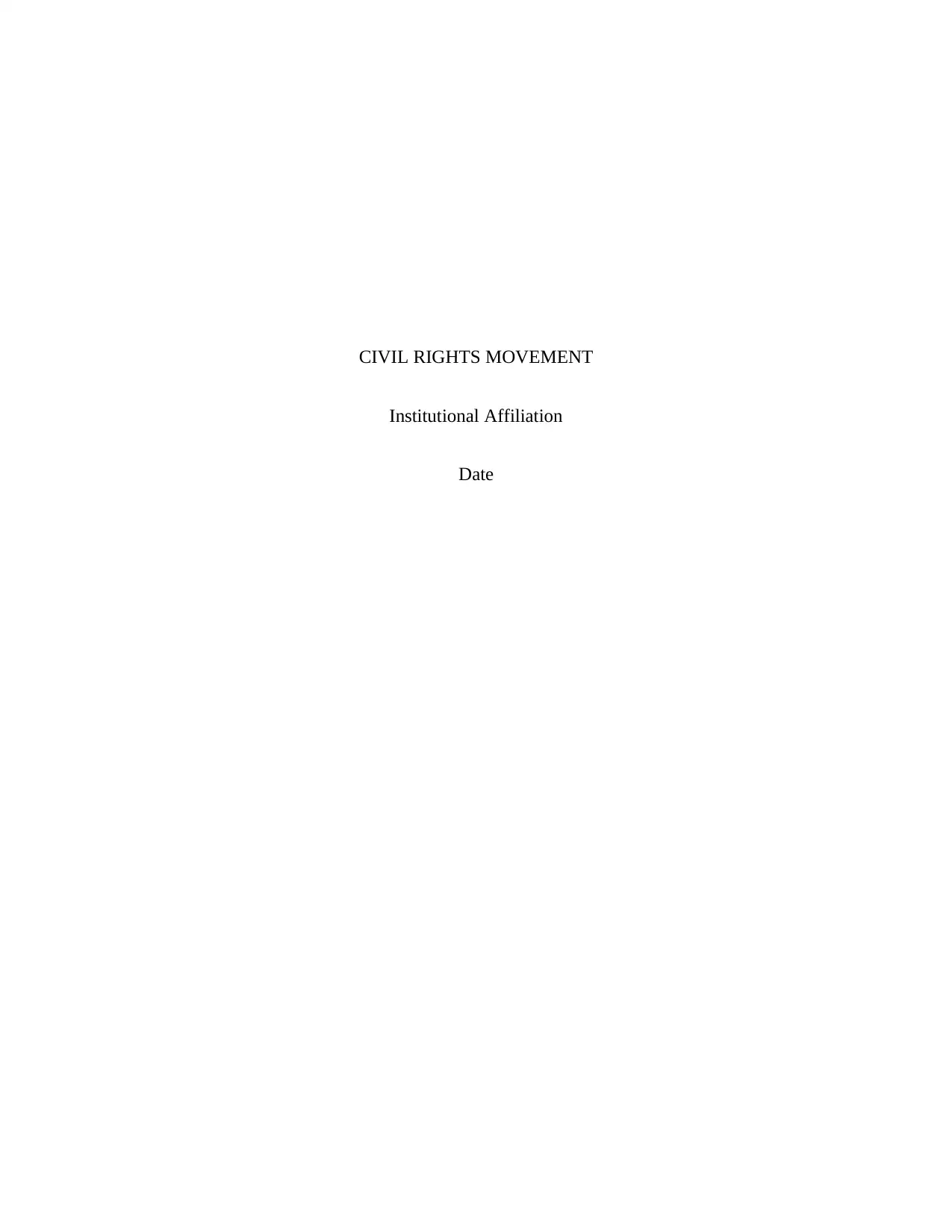
CIVIL RIGHTS MOVEMENT
Institutional Affiliation
Date
Institutional Affiliation
Date
Paraphrase This Document
Need a fresh take? Get an instant paraphrase of this document with our AI Paraphraser
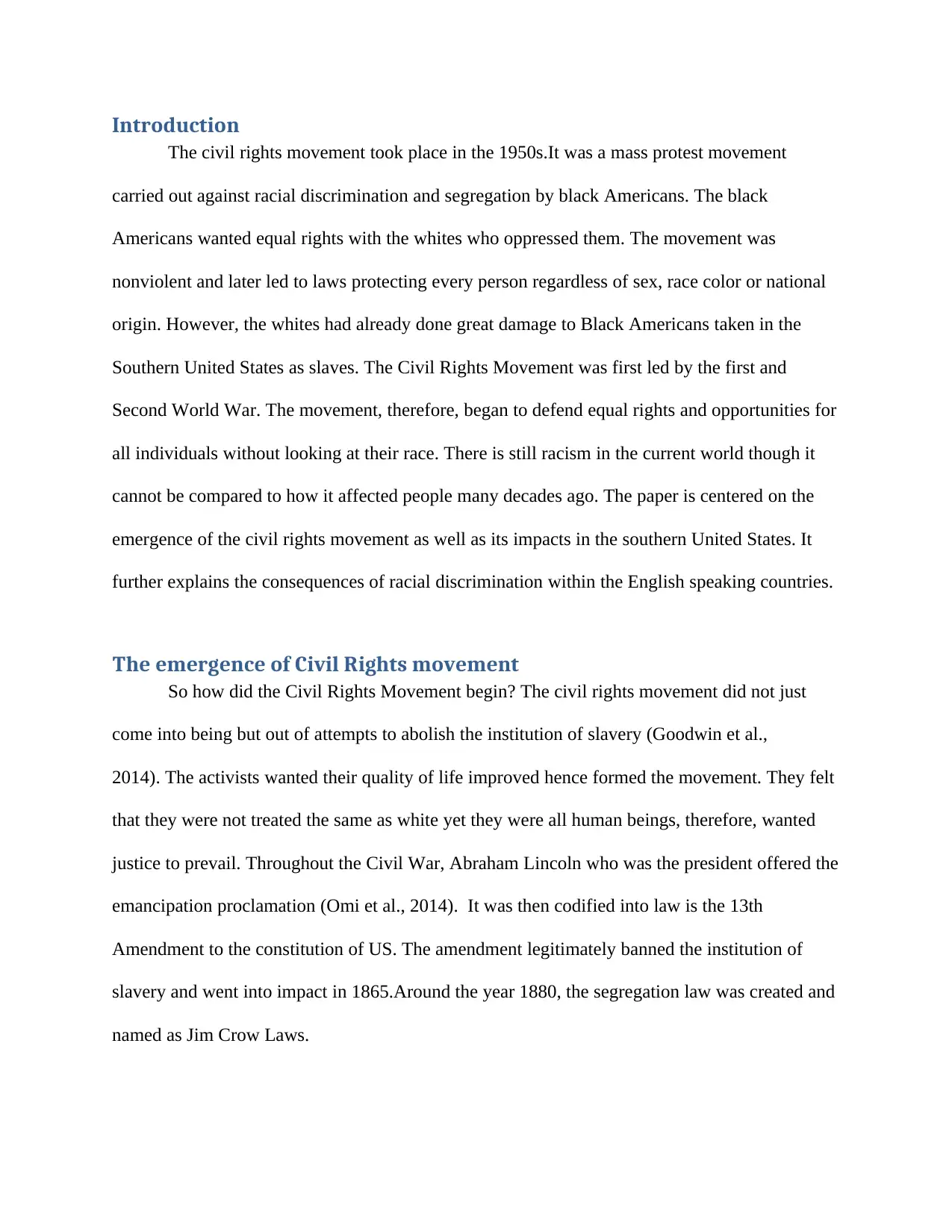
Introduction
The civil rights movement took place in the 1950s.It was a mass protest movement
carried out against racial discrimination and segregation by black Americans. The black
Americans wanted equal rights with the whites who oppressed them. The movement was
nonviolent and later led to laws protecting every person regardless of sex, race color or national
origin. However, the whites had already done great damage to Black Americans taken in the
Southern United States as slaves. The Civil Rights Movement was first led by the first and
Second World War. The movement, therefore, began to defend equal rights and opportunities for
all individuals without looking at their race. There is still racism in the current world though it
cannot be compared to how it affected people many decades ago. The paper is centered on the
emergence of the civil rights movement as well as its impacts in the southern United States. It
further explains the consequences of racial discrimination within the English speaking countries.
The emergence of Civil Rights movement
So how did the Civil Rights Movement begin? The civil rights movement did not just
come into being but out of attempts to abolish the institution of slavery (Goodwin et al.,
2014). The activists wanted their quality of life improved hence formed the movement. They felt
that they were not treated the same as white yet they were all human beings, therefore, wanted
justice to prevail. Throughout the Civil War, Abraham Lincoln who was the president offered the
emancipation proclamation (Omi et al., 2014). It was then codified into law is the 13th
Amendment to the constitution of US. The amendment legitimately banned the institution of
slavery and went into impact in 1865.Around the year 1880, the segregation law was created and
named as Jim Crow Laws.
The civil rights movement took place in the 1950s.It was a mass protest movement
carried out against racial discrimination and segregation by black Americans. The black
Americans wanted equal rights with the whites who oppressed them. The movement was
nonviolent and later led to laws protecting every person regardless of sex, race color or national
origin. However, the whites had already done great damage to Black Americans taken in the
Southern United States as slaves. The Civil Rights Movement was first led by the first and
Second World War. The movement, therefore, began to defend equal rights and opportunities for
all individuals without looking at their race. There is still racism in the current world though it
cannot be compared to how it affected people many decades ago. The paper is centered on the
emergence of the civil rights movement as well as its impacts in the southern United States. It
further explains the consequences of racial discrimination within the English speaking countries.
The emergence of Civil Rights movement
So how did the Civil Rights Movement begin? The civil rights movement did not just
come into being but out of attempts to abolish the institution of slavery (Goodwin et al.,
2014). The activists wanted their quality of life improved hence formed the movement. They felt
that they were not treated the same as white yet they were all human beings, therefore, wanted
justice to prevail. Throughout the Civil War, Abraham Lincoln who was the president offered the
emancipation proclamation (Omi et al., 2014). It was then codified into law is the 13th
Amendment to the constitution of US. The amendment legitimately banned the institution of
slavery and went into impact in 1865.Around the year 1880, the segregation law was created and
named as Jim Crow Laws.

The law gave the states the right to enforce legal punishments on individuals for
consorting with people of a different race. This implied that the blacks could not mingle with the
whites. The blacks were supposed to be on their own so as the whites (West, 2014).Many laws
were formed following the segregation laws. For instance, the blacks and whites could not have
access to the similar public facility with whites. In fact, every race had own entryway, bathroom,
and waiting room. Besides, the blacks and whites could not attend the same public school. More
so, the interracial marriages were banned completely. As a result, people who went against these
rules were severely punished or jailed according to Jim Crow Laws.
Activists involved in Civil Rights movement
For many years of Liberation Proclamation, the blacks in Southern states continued to
suffer. They lived a rigid unsatisfactory world of segregation, citizenship deprivation and other
forms of tyranny which included race-inspired difficulty (Button, 2014). Jim crow laws at state
and local states. The non-violent movement and civil disobedient approaches were employed by
the activists to bring some change. A number of civil rights leaders within the community of
blacks and beyond were recognized during that period. Some of the leaders include Martin
Luther King, Andrew Goodman, Rosa Parks as well as other leaders of the Christian group. In
fact, a number of them endangered their life as many also lost their lives in the name of equality
and freedom. Their motive behind the civil right movement involved school segregation. Rosa
Park is said to have refused to give offer her seat to the white person, despite that it was public
accommodation and transportation(Goodwin et al., 2014). Also, there was the murder of a
fourteen-year-old in Chicago school. The deeds, in fact, led to all coming together to fight
against the segregation.
consorting with people of a different race. This implied that the blacks could not mingle with the
whites. The blacks were supposed to be on their own so as the whites (West, 2014).Many laws
were formed following the segregation laws. For instance, the blacks and whites could not have
access to the similar public facility with whites. In fact, every race had own entryway, bathroom,
and waiting room. Besides, the blacks and whites could not attend the same public school. More
so, the interracial marriages were banned completely. As a result, people who went against these
rules were severely punished or jailed according to Jim Crow Laws.
Activists involved in Civil Rights movement
For many years of Liberation Proclamation, the blacks in Southern states continued to
suffer. They lived a rigid unsatisfactory world of segregation, citizenship deprivation and other
forms of tyranny which included race-inspired difficulty (Button, 2014). Jim crow laws at state
and local states. The non-violent movement and civil disobedient approaches were employed by
the activists to bring some change. A number of civil rights leaders within the community of
blacks and beyond were recognized during that period. Some of the leaders include Martin
Luther King, Andrew Goodman, Rosa Parks as well as other leaders of the Christian group. In
fact, a number of them endangered their life as many also lost their lives in the name of equality
and freedom. Their motive behind the civil right movement involved school segregation. Rosa
Park is said to have refused to give offer her seat to the white person, despite that it was public
accommodation and transportation(Goodwin et al., 2014). Also, there was the murder of a
fourteen-year-old in Chicago school. The deeds, in fact, led to all coming together to fight
against the segregation.
⊘ This is a preview!⊘
Do you want full access?
Subscribe today to unlock all pages.

Trusted by 1+ million students worldwide
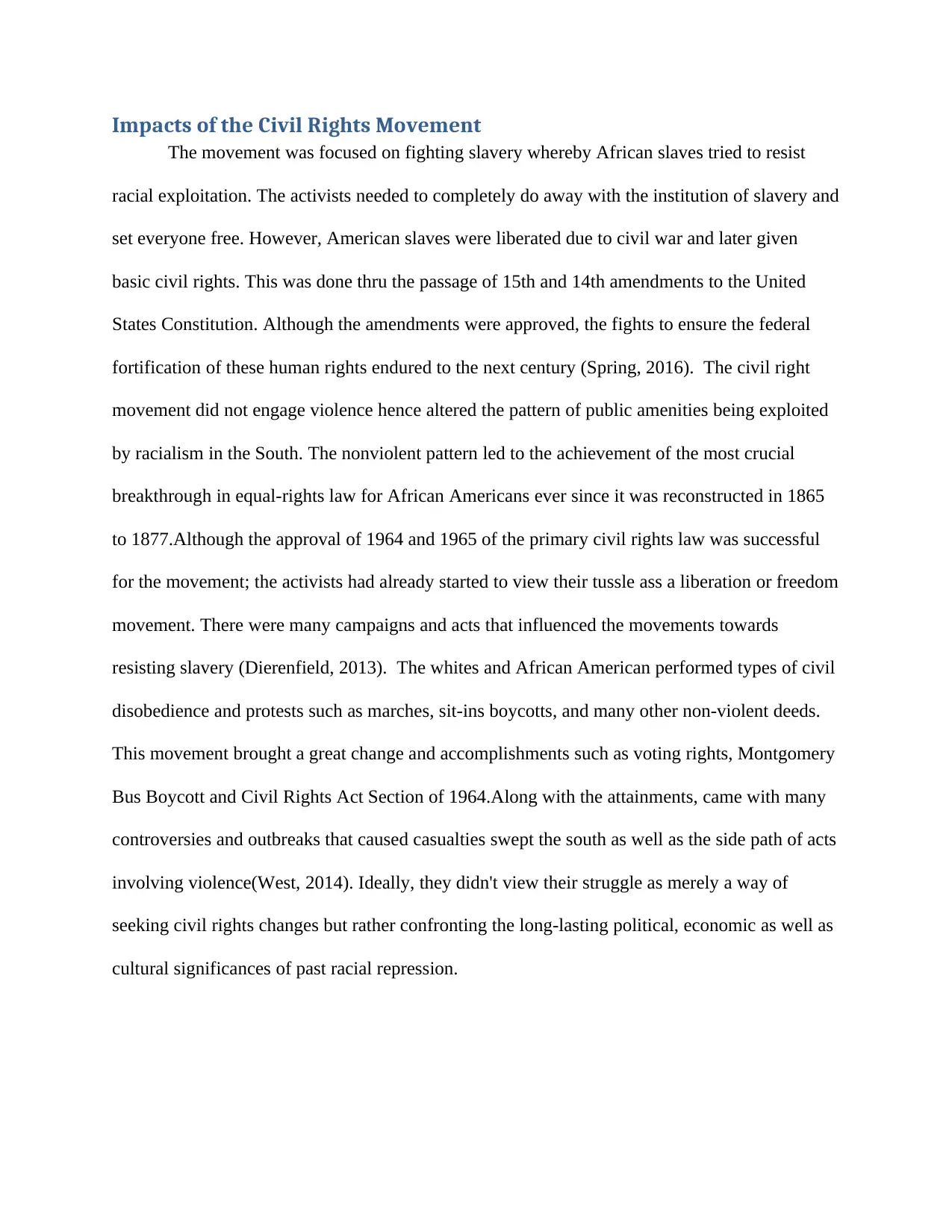
Impacts of the Civil Rights Movement
The movement was focused on fighting slavery whereby African slaves tried to resist
racial exploitation. The activists needed to completely do away with the institution of slavery and
set everyone free. However, American slaves were liberated due to civil war and later given
basic civil rights. This was done thru the passage of 15th and 14th amendments to the United
States Constitution. Although the amendments were approved, the fights to ensure the federal
fortification of these human rights endured to the next century (Spring, 2016). The civil right
movement did not engage violence hence altered the pattern of public amenities being exploited
by racialism in the South. The nonviolent pattern led to the achievement of the most crucial
breakthrough in equal-rights law for African Americans ever since it was reconstructed in 1865
to 1877.Although the approval of 1964 and 1965 of the primary civil rights law was successful
for the movement; the activists had already started to view their tussle ass a liberation or freedom
movement. There were many campaigns and acts that influenced the movements towards
resisting slavery (Dierenfield, 2013). The whites and African American performed types of civil
disobedience and protests such as marches, sit-ins boycotts, and many other non-violent deeds.
This movement brought a great change and accomplishments such as voting rights, Montgomery
Bus Boycott and Civil Rights Act Section of 1964.Along with the attainments, came with many
controversies and outbreaks that caused casualties swept the south as well as the side path of acts
involving violence(West, 2014). Ideally, they didn't view their struggle as merely a way of
seeking civil rights changes but rather confronting the long-lasting political, economic as well as
cultural significances of past racial repression.
The movement was focused on fighting slavery whereby African slaves tried to resist
racial exploitation. The activists needed to completely do away with the institution of slavery and
set everyone free. However, American slaves were liberated due to civil war and later given
basic civil rights. This was done thru the passage of 15th and 14th amendments to the United
States Constitution. Although the amendments were approved, the fights to ensure the federal
fortification of these human rights endured to the next century (Spring, 2016). The civil right
movement did not engage violence hence altered the pattern of public amenities being exploited
by racialism in the South. The nonviolent pattern led to the achievement of the most crucial
breakthrough in equal-rights law for African Americans ever since it was reconstructed in 1865
to 1877.Although the approval of 1964 and 1965 of the primary civil rights law was successful
for the movement; the activists had already started to view their tussle ass a liberation or freedom
movement. There were many campaigns and acts that influenced the movements towards
resisting slavery (Dierenfield, 2013). The whites and African American performed types of civil
disobedience and protests such as marches, sit-ins boycotts, and many other non-violent deeds.
This movement brought a great change and accomplishments such as voting rights, Montgomery
Bus Boycott and Civil Rights Act Section of 1964.Along with the attainments, came with many
controversies and outbreaks that caused casualties swept the south as well as the side path of acts
involving violence(West, 2014). Ideally, they didn't view their struggle as merely a way of
seeking civil rights changes but rather confronting the long-lasting political, economic as well as
cultural significances of past racial repression.
Paraphrase This Document
Need a fresh take? Get an instant paraphrase of this document with our AI Paraphraser
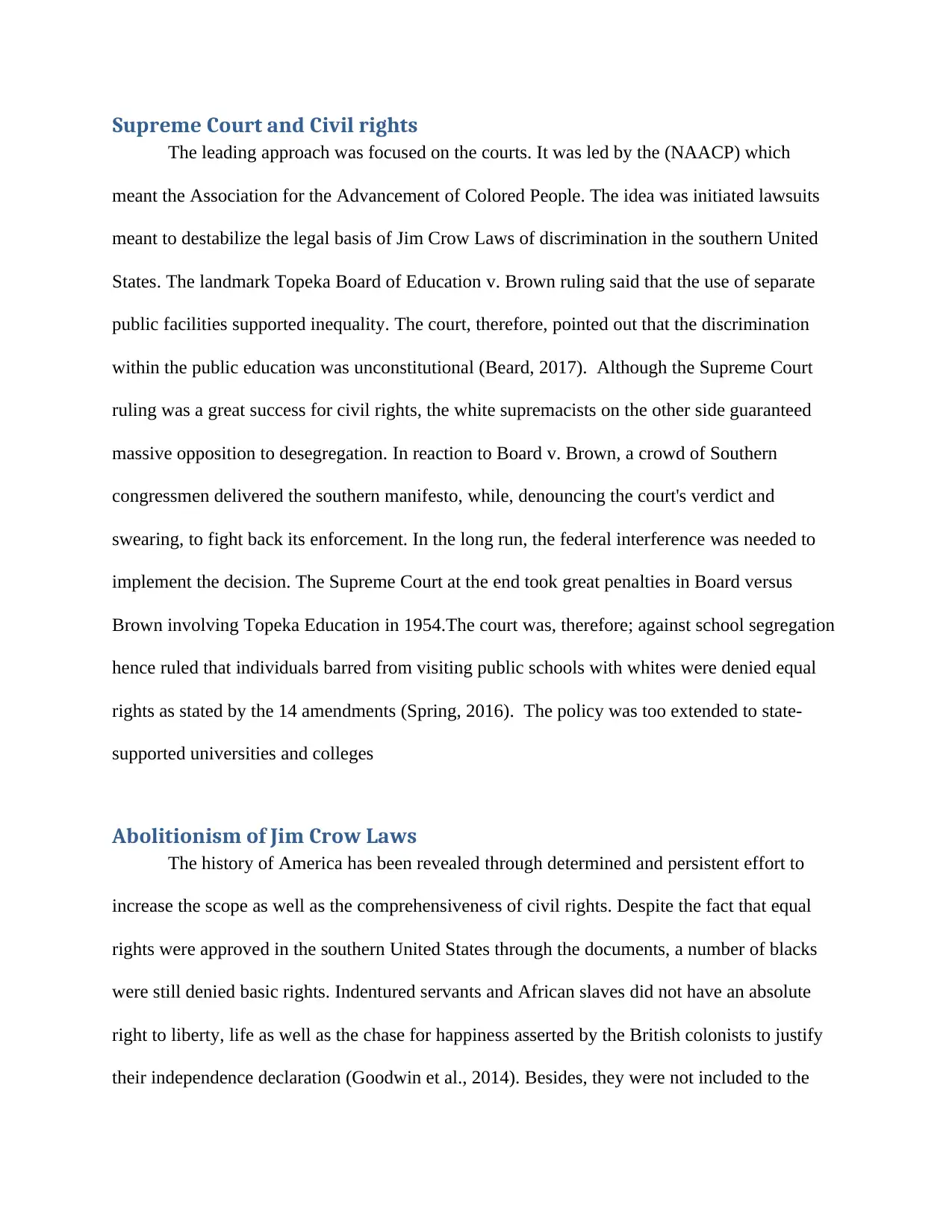
Supreme Court and Civil rights
The leading approach was focused on the courts. It was led by the (NAACP) which
meant the Association for the Advancement of Colored People. The idea was initiated lawsuits
meant to destabilize the legal basis of Jim Crow Laws of discrimination in the southern United
States. The landmark Topeka Board of Education v. Brown ruling said that the use of separate
public facilities supported inequality. The court, therefore, pointed out that the discrimination
within the public education was unconstitutional (Beard, 2017). Although the Supreme Court
ruling was a great success for civil rights, the white supremacists on the other side guaranteed
massive opposition to desegregation. In reaction to Board v. Brown, a crowd of Southern
congressmen delivered the southern manifesto, while, denouncing the court's verdict and
swearing, to fight back its enforcement. In the long run, the federal interference was needed to
implement the decision. The Supreme Court at the end took great penalties in Board versus
Brown involving Topeka Education in 1954.The court was, therefore; against school segregation
hence ruled that individuals barred from visiting public schools with whites were denied equal
rights as stated by the 14 amendments (Spring, 2016). The policy was too extended to state-
supported universities and colleges
Abolitionism of Jim Crow Laws
The history of America has been revealed through determined and persistent effort to
increase the scope as well as the comprehensiveness of civil rights. Despite the fact that equal
rights were approved in the southern United States through the documents, a number of blacks
were still denied basic rights. Indentured servants and African slaves did not have an absolute
right to liberty, life as well as the chase for happiness asserted by the British colonists to justify
their independence declaration (Goodwin et al., 2014). Besides, they were not included to the
The leading approach was focused on the courts. It was led by the (NAACP) which
meant the Association for the Advancement of Colored People. The idea was initiated lawsuits
meant to destabilize the legal basis of Jim Crow Laws of discrimination in the southern United
States. The landmark Topeka Board of Education v. Brown ruling said that the use of separate
public facilities supported inequality. The court, therefore, pointed out that the discrimination
within the public education was unconstitutional (Beard, 2017). Although the Supreme Court
ruling was a great success for civil rights, the white supremacists on the other side guaranteed
massive opposition to desegregation. In reaction to Board v. Brown, a crowd of Southern
congressmen delivered the southern manifesto, while, denouncing the court's verdict and
swearing, to fight back its enforcement. In the long run, the federal interference was needed to
implement the decision. The Supreme Court at the end took great penalties in Board versus
Brown involving Topeka Education in 1954.The court was, therefore; against school segregation
hence ruled that individuals barred from visiting public schools with whites were denied equal
rights as stated by the 14 amendments (Spring, 2016). The policy was too extended to state-
supported universities and colleges
Abolitionism of Jim Crow Laws
The history of America has been revealed through determined and persistent effort to
increase the scope as well as the comprehensiveness of civil rights. Despite the fact that equal
rights were approved in the southern United States through the documents, a number of blacks
were still denied basic rights. Indentured servants and African slaves did not have an absolute
right to liberty, life as well as the chase for happiness asserted by the British colonists to justify
their independence declaration (Goodwin et al., 2014). Besides, they were not included to the

United States people who created the constitution to enable general welfare promotion and get
blessings of liberty. However, the constitution only protected slavery by facilitating slaves'
importation till 1808.Besides, the constitution helped in enabling the slaves' return of who had
run to other states for the refugee.
As the Southern United States continued to expand its borders, Native American group
resisted absorption and conquest. The individual states which influenced a number of the rights
of American people limited the rights for voting to white property possessing males and other
basic rights. Some of these rights include; the right to serve on juries and the right to own land.
The Africa-American were denied such rights because of their gender and color. However, the
point is? How does color affect all these activities in the southern United States? The question
still lingers in so many minds wanting to know whether the society still has an issue with the
color. Well, probably things are changing in the current world (Beard, 2017). During that time, a
small group of blacks lived outside the system of the slave. However, those recognized as free
blacks suffered enforced segregation and racial discrimination. Although a few slaves rebelled
violently against their dependence, African Americans as well as other marginalized groups
mostly used nonviolent methods. The protests, pleas, legal challenges and petitions forwarded to
government representatives as well as massive and sustained civil rights movements achieved
gradual enhancements in their status quo.
Black Power
The term black power is a political slogan that spread between the 1960s towards the
1980s.The term also refers to different ideologies meant to achieve autonomy for black
individuals (Button, 2016). It was promoted in the United States, though the slogans together
with other components of the Black Power Movement have already gone abroad. Despite that the
blessings of liberty. However, the constitution only protected slavery by facilitating slaves'
importation till 1808.Besides, the constitution helped in enabling the slaves' return of who had
run to other states for the refugee.
As the Southern United States continued to expand its borders, Native American group
resisted absorption and conquest. The individual states which influenced a number of the rights
of American people limited the rights for voting to white property possessing males and other
basic rights. Some of these rights include; the right to serve on juries and the right to own land.
The Africa-American were denied such rights because of their gender and color. However, the
point is? How does color affect all these activities in the southern United States? The question
still lingers in so many minds wanting to know whether the society still has an issue with the
color. Well, probably things are changing in the current world (Beard, 2017). During that time, a
small group of blacks lived outside the system of the slave. However, those recognized as free
blacks suffered enforced segregation and racial discrimination. Although a few slaves rebelled
violently against their dependence, African Americans as well as other marginalized groups
mostly used nonviolent methods. The protests, pleas, legal challenges and petitions forwarded to
government representatives as well as massive and sustained civil rights movements achieved
gradual enhancements in their status quo.
Black Power
The term black power is a political slogan that spread between the 1960s towards the
1980s.The term also refers to different ideologies meant to achieve autonomy for black
individuals (Button, 2016). It was promoted in the United States, though the slogans together
with other components of the Black Power Movement have already gone abroad. Despite that the
⊘ This is a preview!⊘
Do you want full access?
Subscribe today to unlock all pages.

Trusted by 1+ million students worldwide
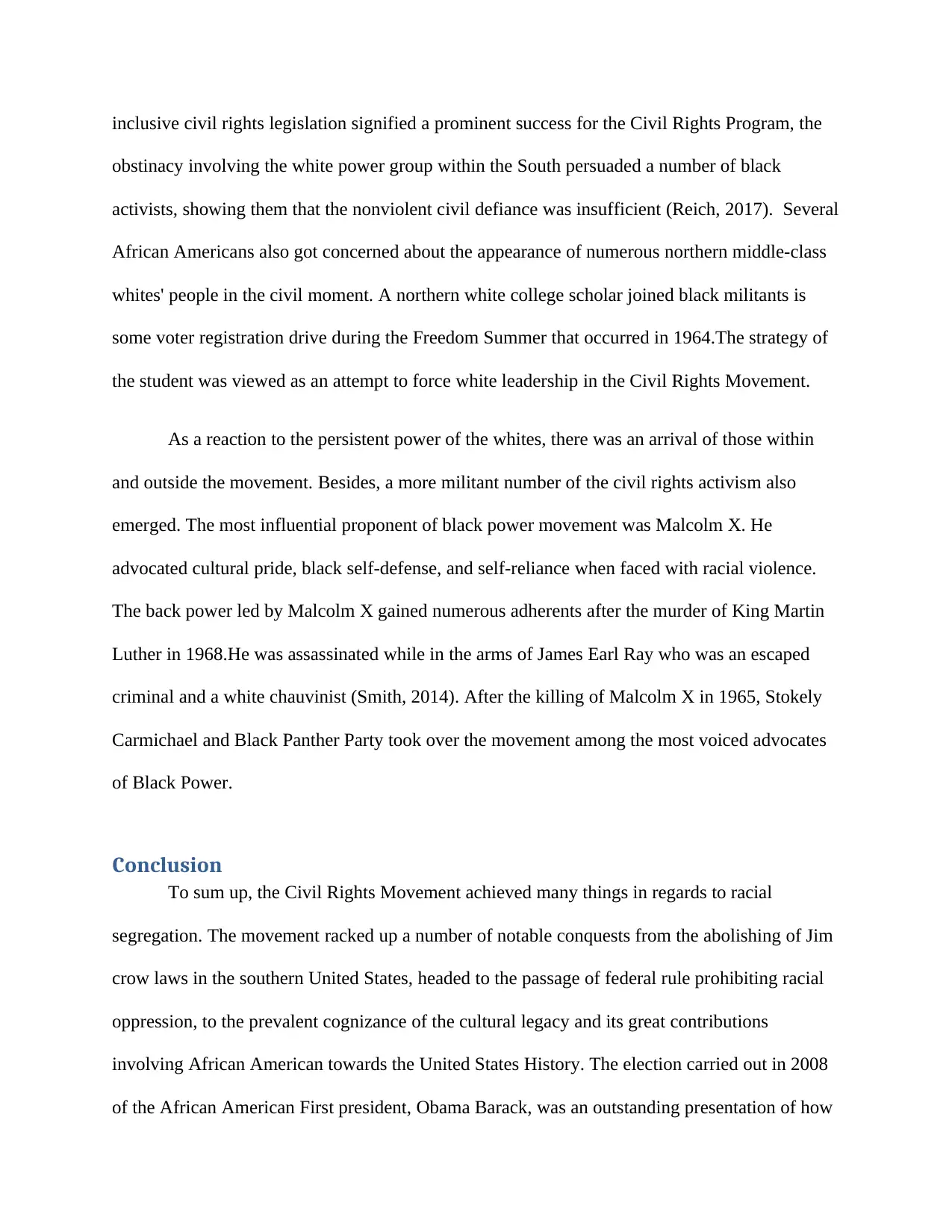
inclusive civil rights legislation signified a prominent success for the Civil Rights Program, the
obstinacy involving the white power group within the South persuaded a number of black
activists, showing them that the nonviolent civil defiance was insufficient (Reich, 2017). Several
African Americans also got concerned about the appearance of numerous northern middle-class
whites' people in the civil moment. A northern white college scholar joined black militants is
some voter registration drive during the Freedom Summer that occurred in 1964.The strategy of
the student was viewed as an attempt to force white leadership in the Civil Rights Movement.
As a reaction to the persistent power of the whites, there was an arrival of those within
and outside the movement. Besides, a more militant number of the civil rights activism also
emerged. The most influential proponent of black power movement was Malcolm X. He
advocated cultural pride, black self-defense, and self-reliance when faced with racial violence.
The back power led by Malcolm X gained numerous adherents after the murder of King Martin
Luther in 1968.He was assassinated while in the arms of James Earl Ray who was an escaped
criminal and a white chauvinist (Smith, 2014). After the killing of Malcolm X in 1965, Stokely
Carmichael and Black Panther Party took over the movement among the most voiced advocates
of Black Power.
Conclusion
To sum up, the Civil Rights Movement achieved many things in regards to racial
segregation. The movement racked up a number of notable conquests from the abolishing of Jim
crow laws in the southern United States, headed to the passage of federal rule prohibiting racial
oppression, to the prevalent cognizance of the cultural legacy and its great contributions
involving African American towards the United States History. The election carried out in 2008
of the African American First president, Obama Barack, was an outstanding presentation of how
obstinacy involving the white power group within the South persuaded a number of black
activists, showing them that the nonviolent civil defiance was insufficient (Reich, 2017). Several
African Americans also got concerned about the appearance of numerous northern middle-class
whites' people in the civil moment. A northern white college scholar joined black militants is
some voter registration drive during the Freedom Summer that occurred in 1964.The strategy of
the student was viewed as an attempt to force white leadership in the Civil Rights Movement.
As a reaction to the persistent power of the whites, there was an arrival of those within
and outside the movement. Besides, a more militant number of the civil rights activism also
emerged. The most influential proponent of black power movement was Malcolm X. He
advocated cultural pride, black self-defense, and self-reliance when faced with racial violence.
The back power led by Malcolm X gained numerous adherents after the murder of King Martin
Luther in 1968.He was assassinated while in the arms of James Earl Ray who was an escaped
criminal and a white chauvinist (Smith, 2014). After the killing of Malcolm X in 1965, Stokely
Carmichael and Black Panther Party took over the movement among the most voiced advocates
of Black Power.
Conclusion
To sum up, the Civil Rights Movement achieved many things in regards to racial
segregation. The movement racked up a number of notable conquests from the abolishing of Jim
crow laws in the southern United States, headed to the passage of federal rule prohibiting racial
oppression, to the prevalent cognizance of the cultural legacy and its great contributions
involving African American towards the United States History. The election carried out in 2008
of the African American First president, Obama Barack, was an outstanding presentation of how
Paraphrase This Document
Need a fresh take? Get an instant paraphrase of this document with our AI Paraphraser
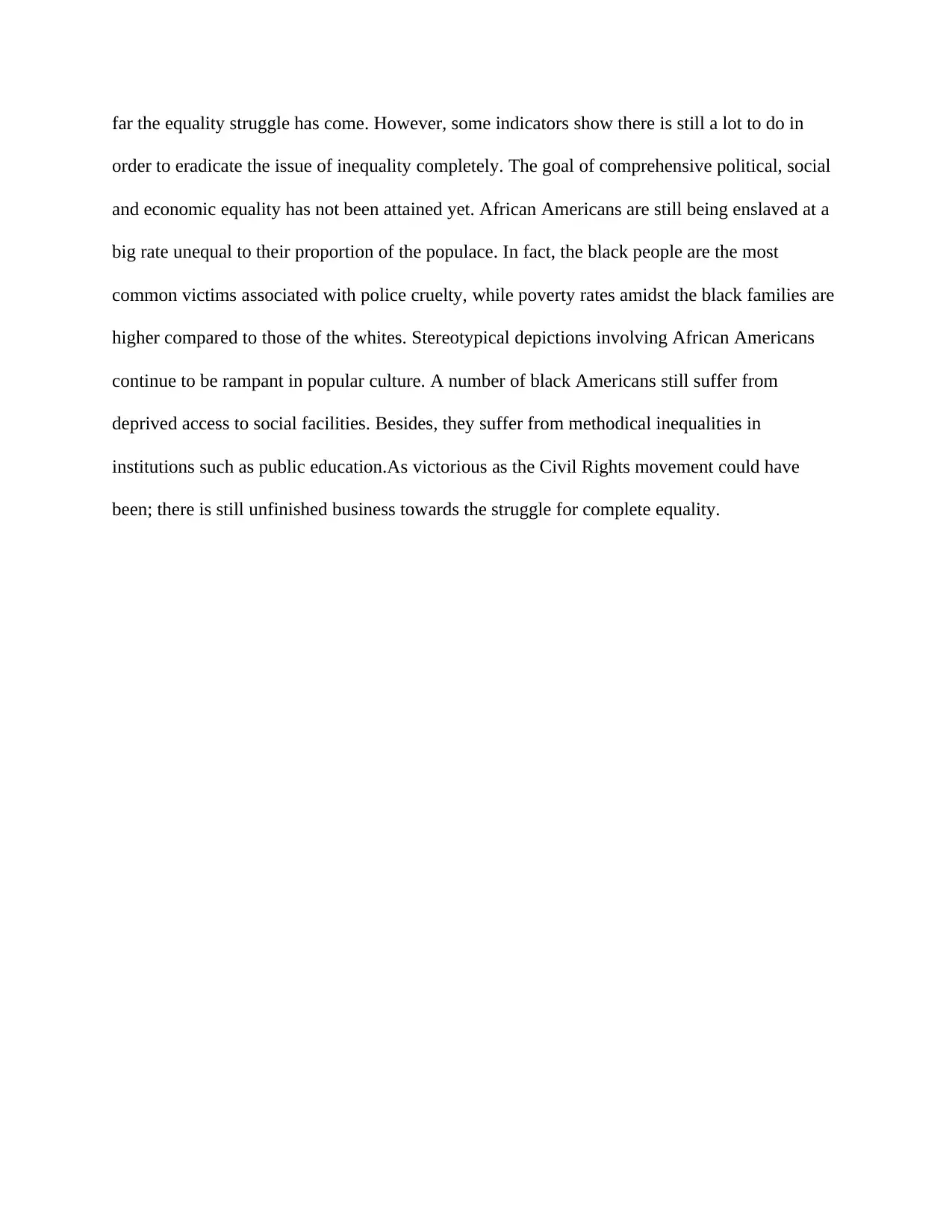
far the equality struggle has come. However, some indicators show there is still a lot to do in
order to eradicate the issue of inequality completely. The goal of comprehensive political, social
and economic equality has not been attained yet. African Americans are still being enslaved at a
big rate unequal to their proportion of the populace. In fact, the black people are the most
common victims associated with police cruelty, while poverty rates amidst the black families are
higher compared to those of the whites. Stereotypical depictions involving African Americans
continue to be rampant in popular culture. A number of black Americans still suffer from
deprived access to social facilities. Besides, they suffer from methodical inequalities in
institutions such as public education.As victorious as the Civil Rights movement could have
been; there is still unfinished business towards the struggle for complete equality.
order to eradicate the issue of inequality completely. The goal of comprehensive political, social
and economic equality has not been attained yet. African Americans are still being enslaved at a
big rate unequal to their proportion of the populace. In fact, the black people are the most
common victims associated with police cruelty, while poverty rates amidst the black families are
higher compared to those of the whites. Stereotypical depictions involving African Americans
continue to be rampant in popular culture. A number of black Americans still suffer from
deprived access to social facilities. Besides, they suffer from methodical inequalities in
institutions such as public education.As victorious as the Civil Rights movement could have
been; there is still unfinished business towards the struggle for complete equality.
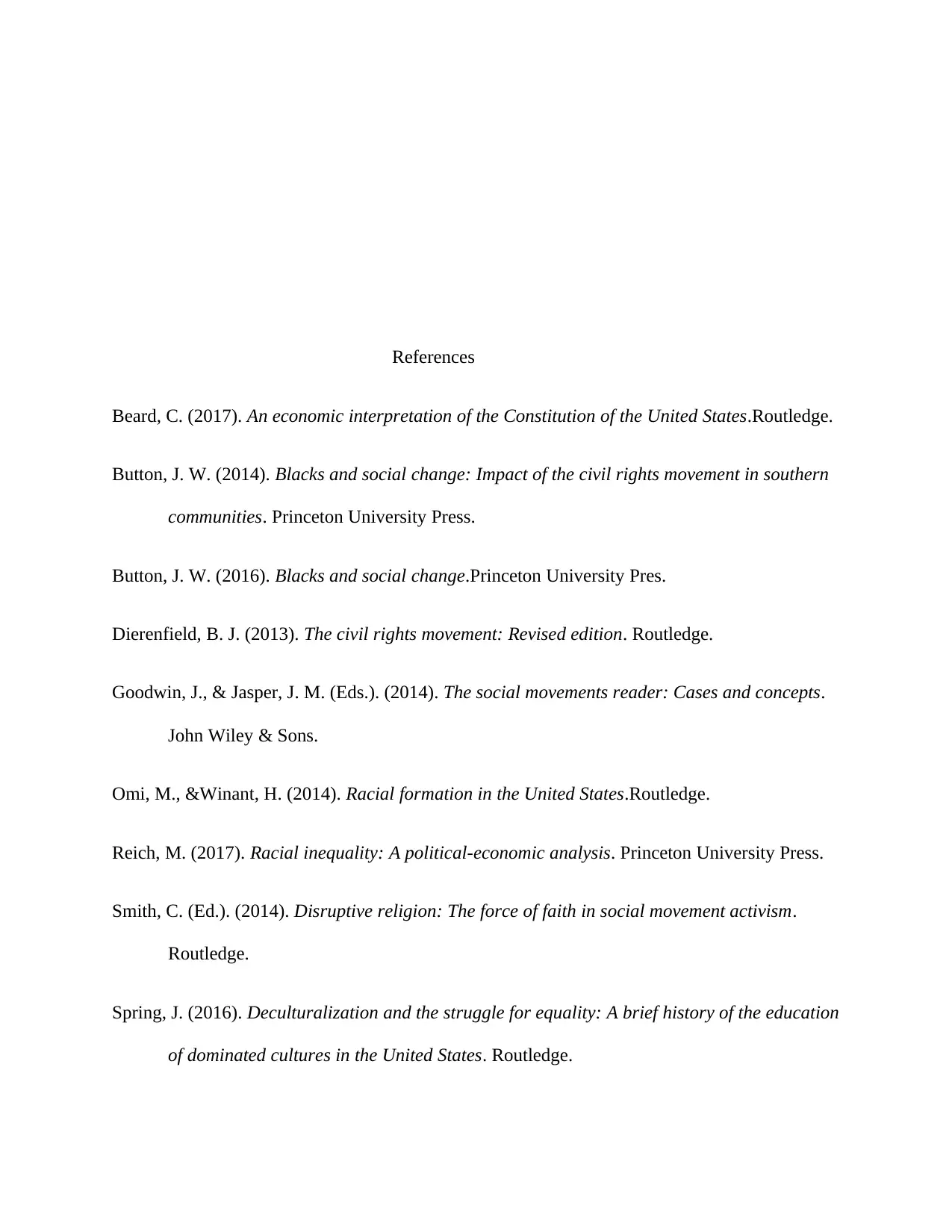
References
Beard, C. (2017). An economic interpretation of the Constitution of the United States.Routledge.
Button, J. W. (2014). Blacks and social change: Impact of the civil rights movement in southern
communities. Princeton University Press.
Button, J. W. (2016). Blacks and social change.Princeton University Pres.
Dierenfield, B. J. (2013). The civil rights movement: Revised edition. Routledge.
Goodwin, J., & Jasper, J. M. (Eds.). (2014). The social movements reader: Cases and concepts.
John Wiley & Sons.
Omi, M., &Winant, H. (2014). Racial formation in the United States.Routledge.
Reich, M. (2017). Racial inequality: A political-economic analysis. Princeton University Press.
Smith, C. (Ed.). (2014). Disruptive religion: The force of faith in social movement activism.
Routledge.
Spring, J. (2016). Deculturalization and the struggle for equality: A brief history of the education
of dominated cultures in the United States. Routledge.
Beard, C. (2017). An economic interpretation of the Constitution of the United States.Routledge.
Button, J. W. (2014). Blacks and social change: Impact of the civil rights movement in southern
communities. Princeton University Press.
Button, J. W. (2016). Blacks and social change.Princeton University Pres.
Dierenfield, B. J. (2013). The civil rights movement: Revised edition. Routledge.
Goodwin, J., & Jasper, J. M. (Eds.). (2014). The social movements reader: Cases and concepts.
John Wiley & Sons.
Omi, M., &Winant, H. (2014). Racial formation in the United States.Routledge.
Reich, M. (2017). Racial inequality: A political-economic analysis. Princeton University Press.
Smith, C. (Ed.). (2014). Disruptive religion: The force of faith in social movement activism.
Routledge.
Spring, J. (2016). Deculturalization and the struggle for equality: A brief history of the education
of dominated cultures in the United States. Routledge.
⊘ This is a preview!⊘
Do you want full access?
Subscribe today to unlock all pages.

Trusted by 1+ million students worldwide

West, M. (2014)." I Want Those Seats:'Rosa Parks, Buses, and the Origins of the Civil Rights
Movement.
Movement.
1 out of 10
Related Documents
Your All-in-One AI-Powered Toolkit for Academic Success.
+13062052269
info@desklib.com
Available 24*7 on WhatsApp / Email
![[object Object]](/_next/static/media/star-bottom.7253800d.svg)
Unlock your academic potential
© 2024 | Zucol Services PVT LTD | All rights reserved.





